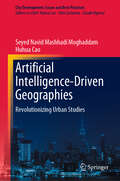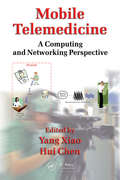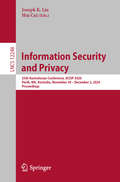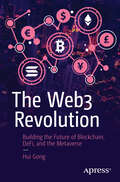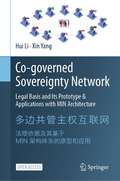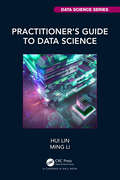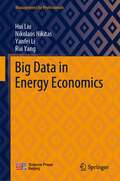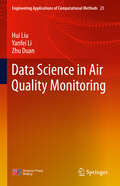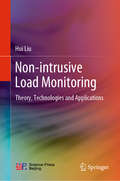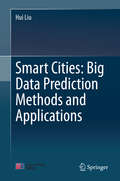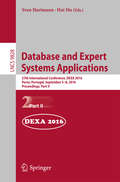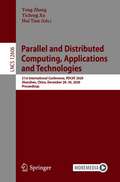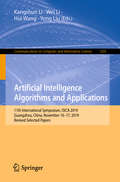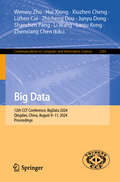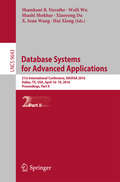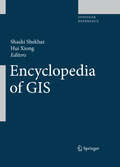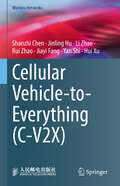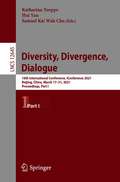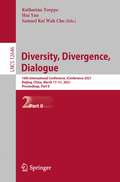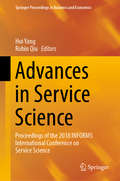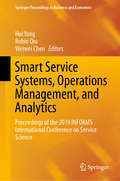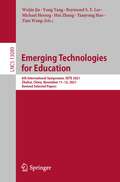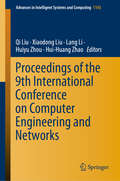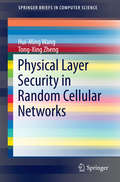- Table View
- List View
Artificial Intelligence-Driven Geographies: Revolutionizing Urban Studies (City Development: Issues and Best Practices)
by Huhua Cao Seyed Navid MoghaddamThis groundbreaking book delves deep into the history of AI, the major techniques and algorithms of machine learning and deep learning, and the critical role of data sources and processing in these disciplines. It covers a range of AI applications in human geography, including population distribution, land use, environmental risk assessment, and socioeconomic analysis. In urban planning, the book explores AI-driven approaches to smart cities, transportation management, urban growth prediction, and sustainable development, among others. As AI continues to permeate every aspect of human life, it is essential to understand and address the ethical considerations and challenges associated with AI-driven planning. This book tackles crucial issues such as data privacy, algorithmic bias, equitable access to technology, and the future of employment in the fields of geography and urban planning. In addition, it presents inspiring case studies, highlighting successful AI applications in human geography and urban planning, and offers insights into future research directions and challenges. This book is a must-read for students, researchers, and professionals in geography, urban planning, environmental studies, and related fields. It is also an invaluable resource for policymakers and urban planners seeking to leverage the power of AI to create smarter, more sustainable, and equitable cities and communities. This book equips you with the knowledge and tools to harness the potential of AI, leading the way to a better understanding of our world and a brighter future for all.
Mobile Telemedicine: A Computing and Networking Perspective
by Yang Xiao Hui ChenAdvances in the area of wireless and mobile telemedicine to diagnose and treat patients have drawn growing attention from healthcare providers and recipients, industry, researchers, and governments.This volumeexamines computing and network dilemmas which arise from wireless and mobile telemedicine. Comprised of the contributions of many prominent international researchers, the book gives an overview of patient care and monitoring, discusses the use of telemedicine in cardiology and diabetes, analyzes security and privacy considerations, examines issues relating to networking support, and concludes with a section on the opportunities and challenges that are faced by those involved in this exciting technology.
Information Security and Privacy: 25th Australasian Conference, ACISP 2020, Perth, WA, Australia, November 30 – December 2, 2020, Proceedings (Lecture Notes in Computer Science #12248)
by Joseph K. Liu Hui CuiThis book constitutes the refereed proceedings of the 25th Australasian Conference on Information Security and Privacy, ACISP 2020, held in Perth, WA, Australia, in November 2020*. The 31 revised full papers and 5 short papers presented were carefully revised and selected from 151 submissions. The papers present and discuss the latest research, trends, breakthroughs, and challenges in the domain of information security, privacy and cybersecurity on a variety of topics such as post-quantum cryptography; symmetric cipher; signature; network security and blockchain; cryptographic primitives; mathematical foundation; machine learning security, among others. *The conference was held virtually due to COVID-19 pandemic.
The Web3 Revolution: Building the Future of Blockchain, DeFi, and the Metaverse
by Hui GongWe stand on the cusp of a digital revolution, with Web3 technologies gaining momentum and proving pivotal in shaping the future of finance, art, governance, and social interactions. This comprehensive guide is designed to navigate the intricate world of Web3. Organized in four parts, it offers insightful analysis and explanations on blockchain technology, decentralized finance (DeFi), and the burgeoning realm of the metaverse, providing readers with a holistic understanding of their current state and future potential. Part 1 lays the groundwork by exploring the origins and fundamentals of blockchain technology. From the inception of blockchain and its mechanisms such as hash functions, encryption, and consensus algorithms, to a deep dive into Bitcoin, this section elucidates its operational mechanisms and reflects on its profound impact and the challenges it faces. Part 2 shifts focus to Ethereum and smart contracts, dissecting how Ethereum has expanded blockchain capabilities beyond mere currency. This part covers the details of smart contracts, their applications, the ERC standards that have fostered a plethora of tokens and applications, and Layer 2 solutions essential for scalability. Part 3 delves into DeFi and its applications, elucidating how traditional financial services are being revolutionized. It explores core concepts, mainstream protocols, and unpacks the inherent risks and challenges of DeFi, as well as examining tokenized real-world assets and NFTs, showing how blockchain bridges the digital and physical worlds. Part 4 explores the Web3 ecosystem, focusing on the metaverse and decentralized exchanges. You’ll learn about the metaverse’s potential to create parallel digital worlds, the mechanics of decentralized exchanges, and understand strategies crucial for investment and growth in this space. Whether you are a tech enthusiast, investor, entrepreneur, or simply curious about the future of the internet, The Web3 Revolution provides the essential knowledge to navigate, understand, and prepare for the decentralized future. What You’ll Learn Explore the core of Web3 with in-depth analysis, practical DeFi case studies, and a visionary outlook on its societal impact. Unpack the complexities of blockchain, DeFi, and the metaverse with an extensive and thorough examination, from foundational technologies to futuristic applications. Gain practical insights through detailed case studies on cryptocurrencies and DeFi protocols, coupled with an expert outlook on emerging challenges and how to navigate them. Equip yourself with a forward-looking perspective that illuminates the transformative impact of Web3 on sectors like finance, art, governance, and societal structures, preparing you for the new digital era. Who This Book Is For Tech enthusiasts, investors, entrepreneurs, and those interested in the future of the internet
Co-governed Sovereignty Network: Legal Basis and Its Prototype & Applications with MIN Architecture
by Hui Li Xin YangThis open access book introduces MIN, a novel networking architecture to implement the sovereign equality of all countries in the cyberspace. Combining legal theory and network technology, it first discusses the historical development of sovereignty and expounds the legal basis of cyberspace sovereignty. Then, based on the high-performance blockchain, it describes a new network architecture designed to implement co-governance at the technical level. Explaining network sovereignty and including rich illustrations and tables, the book helps readers new to the field grasp the evolution and necessity of cyberspace sovereignty, gain insights into network trends and develop a preliminary understanding of complex network technologies such as blockchain, security mechanisms and routing strategies. The MIN network implements the “four principles” of cyberspace adopted by most nations and people: respecting cyber sovereignty; maintaining peace and protection; promoting openness and cooperation; and building good order to provide network system security. There maybe three scales of application scenario for MIN, the big one is for UN of Cyberspace, the middle one is for Smart city, the small one is for enterprise group or organizations as private network, MIN-VPN. We have developed the product of MIN-VPN, you could find its message on the preface if care about the security of your network.
Practitioner’s Guide to Data Science (Chapman & Hall/CRC Data Science Series)
by Ming Li Hui LinThis book aims to increase the visibility of data science in real-world, which differs from what you learn from a typical textbook. Many aspects of day-to-day data science work are almost absent from conventional statistics, machine learning, and data science curriculum. Yet these activities account for a considerable share of the time and effort for data professionals in the industry. Based on industry experience, this book outlines real-world scenarios and discusses pitfalls that data science practitioners should avoid. It also covers the big data cloud platform and the art of data science, such as soft skills. The authors use R as the primary tool and provide code for both R and Python. This book is for readers who want to explore possible career paths and eventually become data scientists. This book comprehensively introduces various data science fields, soft and programming skills in data science projects, and potential career paths. Traditional data-related practitioners such as statisticians, business analysts, and data analysts will find this book helpful in expanding their skills for future data science careers. Undergraduate and graduate students from analytics-related areas will find this book beneficial to learn real-world data science applications. Non-mathematical readers will appreciate the reproducibility of the companion R and python codes. Key Features: • It covers both technical and soft skills. • It has a chapter dedicated to the big data cloud environment. For industry applications, the practice of data science is often in such an environment. • It is hands-on. We provide the data and repeatable R and Python code in notebooks. Readers can repeat the analysis in the book using the data and code provided. We also suggest that readers modify the notebook to perform analyses with their data and problems, if possible. The best way to learn data science is to do it!
Spatial Synthesis: Computational Social Science and Humanities (Human Dynamics in Smart Cities)
by Xinyue Ye Hui LinThis book describes how powerful computing technology, emerging big and open data sources, and theoretical perspectives on spatial synthesis have revolutionized the way in which we investigate social sciences and humanities. It summarizes the principles and applications of human-centered computing and spatial social science and humanities research, thereby providing fundamental information that will help shape future research. The book illustrates how big spatiotemporal socioeconomic data facilitate the modelling of individuals’ economic behavior in space and time and how the outcomes of such models can reveal information about economic trends across spatial scales. It describes how spatial social science and humanities research has shifted from a data-scarce to a data-rich environment. The chapters also describe how a powerful analytical framework for identifying space-time research gaps and frontiers is fundamental to comparative study of spatiotemporal phenomena, and how research topics have evolved from structure and function to dynamic and predictive. As such this book provides an interesting read for researchers, students and all those interested in computational and spatial social sciences and humanities.
Big Data in Energy Economics (Management for Professionals)
by Rui Yang Hui Liu Yanfei Li Nikolaos NikitasThis book combines energy economics and big data modeling analysis in energy conversion and management and comprehensively introduces the relevant theories, key technologies, and application examples of the smart energy economy. With the help of time series big data modeling results, energy economy managers develop reasonable and feasible pricing mechanisms of electricity price and improve the absorption capacity of the power grid. In addition, they also carry out scientific power equipment scheduling and cost–benefit analysis according to the results of data mining, so as to avoid the loss caused by accidental damage of equipment. Energy users adjust their power consumption behavior through the modeling results provided and achieve the effect of energy saving and emission reduction while reasonably reducing the electricity expenditure.This book provides an important reference for professionals in related fields such as smart energy, smart economy, energy Internet, artificial intelligence, energy economics and policy.
Data Science in Air Quality Monitoring (Engineering Applications of Computational Methods #23)
by Hui Liu Yanfei Li Zhu DuanThis book presents a series of state-of-the-art methods for air quality monitoring in various engineering environment by using data science. In the book, the data-driven key techniques of the preprocessing, decomposition, identification, clustering, forecasting and interpolation of the air quality monitoring are explained in details with lots of experimental simulation. The book can provide important reference for the development of data science technologies in engineering air quality monitoring. The book can be used for students, engineers, scientists and managers in the fields of environmental engineering, atmospheric science, urban climate, civil engineering, traffic and vehicle engineering, etc.
Non-intrusive Load Monitoring: Theory, Technologies and Applications
by Hui LiuFocusing on non-intrusive load monitoring techniques in the area of smart grids and smart buildings, this book presents a thorough introduction to related basic principles, while also proposing improvements. As the basis of demand-side energy management, the non-intrusive load monitoring techniques are highly promising in terms of their energy-saving and carbon emission reduction potential.The book is structured clearly and written concisely. It introduces each aspect of these techniques with a number of examples, helping readers to understand and use the corresponding results. It provides latest strengths on the non-intrusive load monitoring techniques for engineers and managers of relevant departments. It also offers extensive information and a source of inspiration for researchers and students, while outlining future research directions.
Smart Cities: Big Data Prediction Methods and Applications
by Hui LiuSmart Cities: Big Data Prediction Methods and Applications is the first reference to provide a comprehensive overview of smart cities with the latest big data predicting techniques. This timely book discusses big data forecasting for smart cities. It introduces big data forecasting techniques for the key aspects (e.g., traffic, environment, building energy, green grid, etc.) of smart cities, and explores three key areas that can be improved using big data prediction: grid energy, road traffic networks and environmental health in smart cities. The big data prediction methods proposed in this book are highly significant in terms of the planning, construction, management, control and development of green and smart cities. Including numerous case studies to explain each method and model, this easy-to-understand book appeals to scientists, engineers, college students, postgraduates, teachers and managers from various fields of artificial intelligence, smart cities, smart grid, intelligent traffic systems, intelligent environments and big data computing.
Database and Expert Systems Applications: 27th International Conference, DEXA 2016, Porto, Portugal, September 5-8, 2016, Proceedings, Part II (Lecture Notes in Computer Science #9828)
by Sven Hartmann Hui MaThis two volume set LNCS 9827 and LNCS 9828 constitutes the refereed proceedings of the 27th International Conference on Database and Expert Systems Applications, DEXA 2016, held in Porto, Portugal, September 2016. The 39 revised full papers presented together with 29 short papers were carefully reviewed and selected from 137 submissions. The papers discuss a range of topics including: Temporal, Spatial, and High Dimensional Databases; Data Mining; Authenticity, Privacy, Security, and Trust; Data Clustering; Distributed and Big Data Processing; Decision Support Systems, and Learning; Data Streams; Data Integration, and Interoperability; Semantic Web, and Data Semantics; Social Networks, and Network Analysis; Linked Data; Data Analysis; NoSQL, NewSQL; Multimedia Data; Personal Information Management; Semantic Web and Ontologies; Database and Information System Architectures; Query Answering and Optimization; Information Retrieval, and Keyword Search; Data Modelling, and Uncertainty.
Parallel and Distributed Computing, Applications and Technologies: 21st International Conference, PDCAT 2020, Shenzhen, China, December 28–30, 2020, Proceedings (Lecture Notes in Computer Science #12606)
by Yong Zhang Hui Tian Yicheng XuThis book constitutes the proceedings of the 21st International Conference on Parallel and Distributed Computing, Applications, and Technologies, PDCAT 2020, which took place in Shenzhen, China, during December 28-30, 2020.The 34 full papers included in this volume were carefully reviewed and selected from 109 submissions. They deal with parallel and distributed computing of networking and architectures, software systems and technologies, algorithms and applications, and security and privacy.
Artificial Intelligence Algorithms and Applications: 11th International Symposium, ISICA 2019, Guangzhou, China, November 16–17, 2019, Revised Selected Papers (Communications in Computer and Information Science #1205)
by Wei Li Yong Liu Kangshun Li Hui WangThis book constitutes the thoroughly refereed proceedings of the 11th International Symposium on Intelligence Computation and Applications, ISICA 2019, held in Guangzhou, China, in November 2019.The 65 papers presented were carefully reviewed and selected from the total of 112 submissions. This volume features the most up-to-date research in evolutionary algorithms, parallel computing and quantum computing, evolutionary multi-objective and dynamic optimization, intelligent multimedia systems, virtualization and AI applications, smart scheduling, intelligent control, big data and cloud computing, deep learning, and hybrid machine learning systems.The papers are organized according to the following topical sections: new frontier in evolutionary algorithms; evolutionary multi-objective and dynamic optimization; intelligent multimedia systems; virtualization and AI applications; smart scheduling; intelligent control; big data and cloud computing; statistical learning.
Big Data: 12th CCF Conference, BigData 2024, Qingdao, China, August 9–11, 2024, Proceedings (Communications in Computer and Information Science #2301)
by Hui Xiong Li Wang Wenwu Zhu Zhicheng Dou Xiuzhen Cheng Zhenxiang Chen Lizhen Cui Junyu Dong Shanchen Pang Lanju Kong“This book constitutes the refereed proceedings of the 12th CCF Conference on BigData 2024, which took place in Qingdao, China, in August 2024” to “This book constitutes the refereed proceedings of the 12th CCF Conference on BigData 2024, which took place in Qingdao, China, during 9-11 August, 2024. The 26 full papers presented in this volume were carefully reviewed and selected from 219 submissions. The topics of accepted papers include Big data, Data Science, System Architecture and Infrastructure, Storage Management, Parallel Computing, Analysis Mining and Intelligent Computing, Collection and Preprocessing, Governance.
Database Systems for Advanced Applications: 21st International Conference, DASFAA 2016, Dallas, TX, USA, April 16-19, 2016, Proceedings, Part II (Lecture Notes in Computer Science #9643)
by Shashi Shekhar Hui Xiong X. Sean Wang Shamkant B. Navathe Weili Wu Xiaoyong DuThis two volume set LNCS 9642 and LNCS 9643 constitutesthe refereed proceedings of the 21st International Conference on DatabaseSystems for Advanced Applications, DASFAA 2016, held in Dallas, TX, USA, inApril 2016. The 61 full papers presented were carefully reviewed andselected from a total of 183 submissions. The papers cover the followingtopics: crowdsourcing, data quality, entity identification, data mining andmachine learning, recommendation, semantics computing and knowledge base,textual data, social networks, complex queries, similarity computing, graphdatabases, and miscellaneous, advanced applications.
Encyclopedia of GIS
by Shashi Shekhar Hui XiongThe Encyclopedia of GIS provides a comprehensive and authoritative guide, contributed by experts and peer-reviewed for accuracy, and alphabetically arranged for convenient access. The entries explain key software and processes used by geographers and computational scientists. Major overviews are provided for nearly 200 topics: Geoinformatics, Spatial Cognition, and Location-Based Services and more. Shorter entries define specific terms and concepts. The reference will be published as a print volume with abundant black and white art, and simultaneously as an XML online reference with hyperlinked citations, cross-references, four-color art, links to web-based maps, and other interactive features.
Cellular Vehicle-to-Everything (Wireless Networks)
by Shanzhi Chen Yan Shi Li Zhao Hui Xu Rui Zhao Jinling Hu Jiayi FangThis book focuses on cellular Vehicle-to-Everything (C-V2X), currently the most promising wireless communication technology for Vehicle-to-Vehicle (V2V), Vehicle-to-Infrastructure (V2I), Vehicle-to-Pedestrian (V2P), Vehicle-to-Network (V2N) and Vehicle-to-Cloud (V2C) communications. Because of its low latency and high reliability, C-V2X has become an essential enabling technology for Intelligent Transportation Systems (ITSs) and autonomous driving. This book begins by introducing readers to the research background and status quo of global development. Then, after analyzing the performance requirements of various V2X applications, the system architecture and technical standards are presented. The two evolving stages of C-V2X, i.e., LTE-V2X and NR-V2X, are introduced in detail. In addition, related technologies such as mobile edge computing, network slicing and high-precision positioning, C-V2X security, C-V2X spectrum requirements and planning, and industrial development and applications are introduced. In closing, the book discusses future applications of and technical challenges for C-V2X. This book is the first monograph dedicated to C-V2X, offering experts, researchers and engineers from the areas of IT/CT, intelligent transportation, intelligent and connected vehicles (ICVs) an in-depth understanding of C-V2X technology and standards, while also outlining related interdisciplinary research. The book can also be used as a reference resource for both undergraduate and graduate studies.
Diversity, Divergence, Dialogue: 16th International Conference, iConference 2021, Beijing, China, March 17–31, 2021, Proceedings, Part I (Lecture Notes in Computer Science #12645)
by Samuel Kai Wah Chu Katharina Toeppe Hui YanThis two-volume set LNCS 12645-12646 constitutes the refereed proceedings of the 16th International Conference on Diversity, Divergence, Dialogue, iConference 2021, held in Beijing, China, in March 2021. The 32 full papers and the 59 short papers presented in this volume were carefully reviewed and selected from 225 submissions. They cover topics such as: AI and machine learning; data science; human-computer interaction; social media; digital humanities; education and information literacy; information behavior; information governance and ethics; archives and records; research methods; and institutional management.
Diversity, Divergence, Dialogue: 16th International Conference, iConference 2021, Beijing, China, March 17–31, 2021, Proceedings, Part II (Lecture Notes in Computer Science #12646)
by Samuel Kai Wah Chu Katharina Toeppe Hui YanThis two-volume set LNCS 12645-12646 constitutes the refereed proceedings of the 16th International Conference on Diversity, Divergence, Dialogue, iConference 2021, held in Beijing, China, in March 2021. The 32 full papers and the 59 short papers presented in this two-volume set were carefully reviewed and selected from 225 submissions. They cover topics such as: AI and machine learning; data science; human-computer interaction; social media; digital humanities; education and information literacy; information behavior; information governance and ethics; archives and records; research methods; and institutional management.
Advances in Service Science: Proceedings of the 2018 INFORMS International Conference on Service Science (Springer Proceedings in Business and Economics)
by Hui Yang Robin QiuThis volume offers the state-of-the-art research and developments in service science and related research, education and practice areas. It showcases emerging technology and applications in fields including healthcare, information technology, transportation, sports, logistics, and public services. Regardless of size and service, a service organization is a service system. Because of the socio-technical nature of a service system, a systems approach must be adopted to design, develop, and deliver services, aimed at meeting end users' both utilitarian and socio-psychological needs. Effective understanding of service and service systems often requires combining multiple methods to consider how interactions of people, technology, organizations, and information create value under various conditions. The papers in this volume highlight ways to approach such technical challenges in service science and are based on submissions from the 2018 INFORMS International Conference on Service Science.
Smart Service Systems, Operations Management, and Analytics: Proceedings of the 2019 INFORMS International Conference on Service Science (Springer Proceedings in Business and Economics)
by Hui Yang Weiwei Chen Robin QiuThis volume offers state-of-the-art research in service science and its related research, education and practice areas. It showcases recent developments in smart service systems, operations management and analytics and their impact in complex service systems. The papers included in this volume highlight emerging technology and applications in fields including healthcare, energy, finance, information technology, transportation, sports, logistics, and public services. Regardless of size and service, a service organization is a service system. Because of the socio-technical nature of a service system, a systems approach must be adopted to design, develop, and deliver services, aimed at meeting end users‘ both utilitarian and socio-psychological needs. Effective understanding of service and service systems often requires combining multiple methods to consider how interactions of people, technology, organizations, and information create value under various conditions. The papers in this volume present methods to approach such technical challenges in service science and are based on top papers from the 2019 INFORMS International Conference on Service Science.
Emerging Technologies for Education: 6th International Symposium, SETE 2021, Zhuhai, China, November 11–12, 2021, Revised Selected Papers (Lecture Notes in Computer Science #13089)
by Hui Zhang Weijia Jia Tianyong Hao Yong Tang Raymond S. T. Lee Michael Herzog Tian WangThis book constitutes the refereed conference proceedings of the 6th International Symposium on Emerging Technologies for Education, SETE 2021, held in Zhuhai, China in November 2021. 35 full papers were accepted together with 8 short papers out of 58 submissions. The papers focus on the following subjects: Emerging Technologies for Education, Digital Technology, Creativity, and Education; Education Technology (Edtech) and ICT for Education; Education + AI; Adaptive Learning, Emotion and Behaviour Recognition and Understanding in Education; as well as papers from the International Symposium on User Modeling and Language Learning (UMLL2021) and the International Workshop on Educational Technology for Language Learning (ETLL 2021).
Proceedings of the 9th International Conference on Computer Engineering and Networks (Advances in Intelligent Systems and Computing #1143)
by Huiyu Zhou Qi Liu Xiaodong Liu Lang Li Hui-Huang ZhaoThis book gathers papers presented at the 9th International Conference on Computer Engineering and Networks (CENet2019), held in Changsha, China, on October 18–20, 2019. It examines innovations in the fields of computer engineering and networking and explores important, state-of-the-art developments in areas such as Information Security, Information Hiding and Cryptography, Cyber Security, and Intelligent Computing and Applications. The book also covers emerging topics in computer engineering and networking, along with their applications, discusses how to improve productivity by using the latest advanced technologies, and examines innovation in the fields of computer engineering and networking, particularly in intelligent computing and security.
Physical Layer Security in Random Cellular Networks
by Hui-Ming Wang Tong-Xing ZhengThis book investigates key security issues in connection with the physical layer for random wireless cellular networks. It first introduces readers to the fundamentals of information theoretic security in the physical layer. By examining recently introduced security techniques for wireless point-to-point communications, the book proposes new solutions to physical layer security based on stochastic geometric frameworks for random cellular networks. It subsequently elaborates on physical-layer security in multi-tier heterogeneous networks. With the new modeled settings, the authors also verify the security performance with the impact of the full-duplex transceivers. The specific model design presented here offers a valuable point of reference for readers in related areas. In addition, the book highlights promising topics and proposes potential future research directions.
